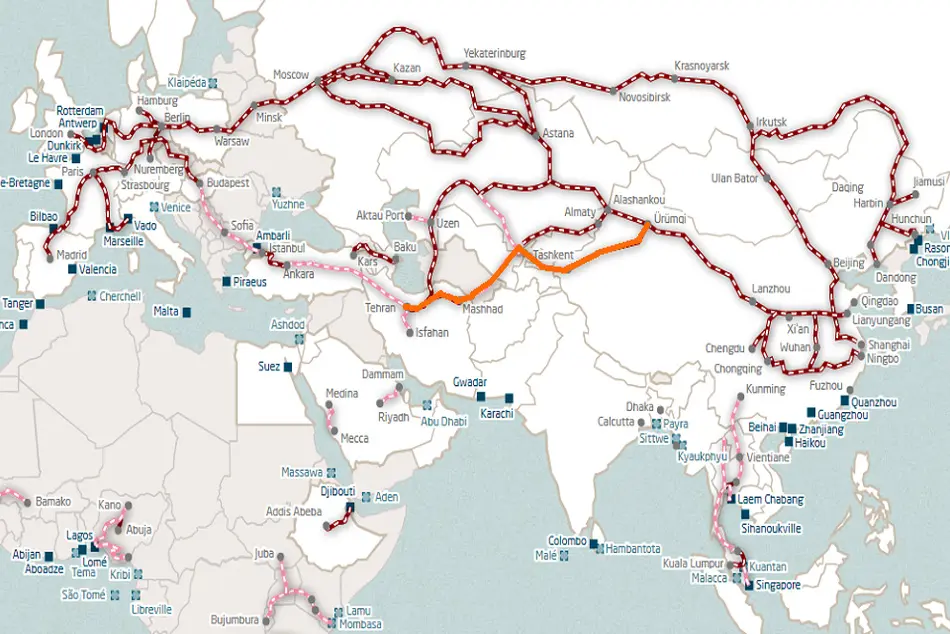From China to Iran via Kyrgyzstan: is the faster rail link real?
Despite all complexities and tensions, China does not cease its efforts to establish a new railway from Xinjiang to Uzbekistan. The future line is expected to run via mountainous Kyrgyzstan and connect the Chinese city of Kashgar with the Fergana Valley in Uzbekistan. In the longer term, the planned route might provide a shorter rail link from China to Iran, Turkey and even to Europe. But to achieve this, many issues remain to be solved.

Despite all complexities and tensions, China does not cease its efforts to establish a new railway from Xinjiang to Uzbekistan. The future line is expected to run via mountainous Kyrgyzstan and connect the Chinese city of Kashgar with the Fergana Valley in Uzbekistan. In the longer term, the planned route might provide a shorter rail link from China to Iran, Turkey and even to Europe. But to achieve this, many issues remain to be solved.
The project of the Xinjiang – Kyrgyzstan – Uzbekistan railway has a long history. It has been discussed for almost a quarter of a century starting from the mid-1990s. There were several periods when China seemed to get closer to launching the project. In 2003 the Kyrgyz government intended to start the feasibility study. Later, in 2011, Kyrgyz officials even declared the start of construction works, which were supposed to be completed in 2018.
Continued postponing
However, none of these plans have been accomplished. The project was postponed each time for various reasons: political tensions and change of cabinets in Kyrgyzstan, as well as technical or financial controversies of the future railway.
Nevertheless, Chinese officeholders continue to discuss the Xinjiang – Kyrgyzstan – Uzbekistan railway with their Central Asian counterparts. This year, the question is on the agenda of the China-Uzbekistan bilateral relations. The project has been discussed during a recent visit (in mid-October) of a Chinese delegation to Uzbekistan. Once again, the Chinese officials emphasised the importance of the planned railway for entire Central Asia and reaffirmed their willingness to implement the project. Why is China so interested in this railway?

Development of Xinjiang
For China, the project is extremely important due to several factors. First, it will stimulate the economic development of the Xinjiang Uygur Autonomous Region. This autonomous region of China plays a significant role in rail freight transportation on the New Silk Road. The majority of container trains from central, eastern and southern China to Europe run via Xinjiang. Its capital, Urumqi, is also an important railway hub on the corridor towards Europe.
Kashgar, one of the westernmost cities in China, could be another junction in Xinjiang. The Chinese government is discussing the construction of two railway lines from Kashgar: one westward to Kyrgyzstan and Uzbekistan, and another southward. The latter heads to Pakistan, where China Overseas Port Holding Company operates Gwadar Deep Sea Port, and where China intends to build its second, after Djibouti, overseas naval base.
New Silk Road
The second factor of success is the potential of the railway line for the New Silk Road. According to estimations, the Xinjiang – Kyrgyzstan – Uzbekistan route will shorten the route from China to Uzbekistan. Currently, containers going to this Central Asian country must cover long distances and cross the territory of neighbouring Kazakhstan.
Moreover, the railway link between China and Uzbekistan links to Iran (via Turkmenistan) and Turkey, as well as eventually to Europe, especially to Southeast Europe. With this, the route from China to Southeast Europe could be reduced up to 900 kilometres, equal to up to seven or eight days. At the same time, the new railway will allow China to better involve Kyrgyzstan and Uzbekistan into the New Silk Road.

Crucial difficulties
Notwithstanding all the opportunities and advantages of the new route, its future remains unclear. But why? Often such projects suffer from the failure to resolve the funding question. In this case, it works but partially. First, there still isn’t any exact price of the project. Initially, it was estimated at 2 billion US dollars (circa 1.8 euros). By 2012, the price was increased up to 7 billion US dollars (around 6.3 billion euros). The amount varies depending on the possible route due to the difficult and mountainous landscape of southern Kyrgyzstan. Therefore, the final value of the project is still unknown.
Another unclarity involves the gauge. The Xinjiang – Kyrgyzstan – Uzbekistan railway will consist of two sections: the Chinese one will be 170 kilometres long and the Kyrgyz part 270 kilometres long. To fasten freight traffic, the Chinese party wants to construct in Kyrgyzstan a railway line with a gauge of 1,435 millimetres, while both Kyrgyzstan and Uzbekistan have tracks of a 1,520 millimetre gauge. The Kyrgyz government is afraid that the new route will bring no benefits to the country and will only use a part of its territory. Therefore, it offered China to construct several other lines with a gauge of 1,520 millimetres across the country. China refused to do this. As a result, both parties still do not have clear understandings on these crucial questions.

Automobile corridor
While the officials are still debating the future of the railway corridor from China to Uzbekistan via Kyrgyzstan, they have managed to operate rail freight via the existing route. In Autumn 2017, three countries examined freight deliveries using semi-trailers.
The pilot trip was carried out from October 30 to 3 November 2017. Nine lorries crossed the 920-kilometre distance on the Kashgar – Tashkent route passing through Irkeshtam and Osh in Kyrgyzstan, as well as Andijan (Andizhan) in Uzbekistan. In February 2018, this route has become a regular line. Moreover, two extensions of the Kashgar – Tashkent automobile corridor, to Turkmenistan and Afghanistan, have also been examined.



